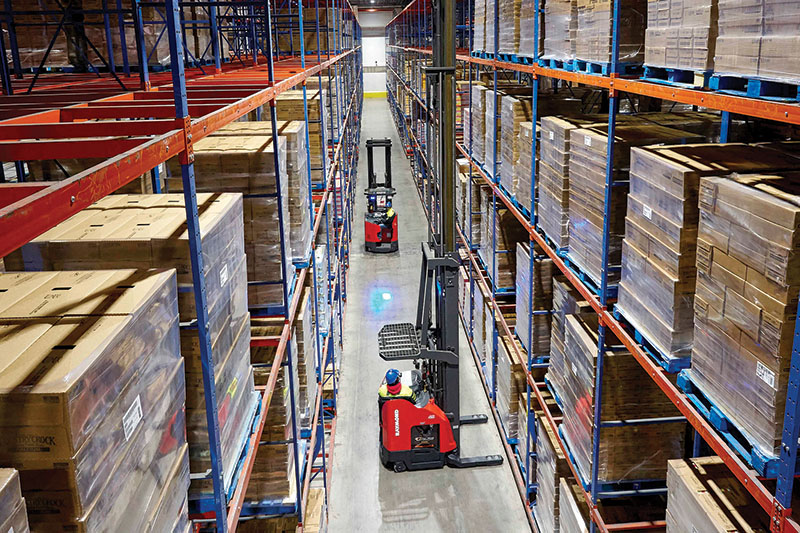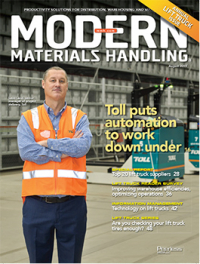Lift Truck Tips: Performance under pressure
Whether aisles are conventional or narrow, the right lift truck will deliver efficient productivity.
Rarely is the pressure for lift trucks to perform efficiently more pronounced than among the expensive, specialized equipment used in narrow or very narrow aisles (VNA). Strangely, however, this rarified segment proves analogous to the broader industry.
Because every unit in service must remain as productive, efficient and safe as possible, every penny per pallet move is precious. Many of the trends and strategies employed among some of the industry’s most sophisticated machines are equally useful for optimizing all forklifts.
According to Susan Comfort, product manager of narrow aisle products for The Raymond Corp., the productivity of every new forklift continues to rise sharply. They’re more efficient, feature higher lift and travel speeds, better motor technology, better acceleration and higher reliability, but even simple changes to handle design are revealing big jumps in productivity.
“Where they used to have separate levers for lift, travel and side shift, now operators can use one hand to simultaneously travel and lift,” Comfort says. “This has created a noticeable increase in productivity and pallet moves per hour, probably around 20% to 30%.”
Although incentives are available to buy the latest equipment, reliability has resulted in customers running equipment longer between maintenance and keeping units longer, Comfort says, from an average of five years to now six or seven.
As operations expand, they will take advantage of vertical space, Comfort points out, since land is expensive and air is free. Lifting capacities in narrow applications are already higher than average, but Comfort says it’s now possible to store almost any pallet at any height. “Twenty years ago 300 inches was a tall truck,” she says. “Now we’re going to 500.”
At those dizzying heights, operators can leverage additional forklift-mounted technologies to preserve productivity and safety. Camera technologies improve visibility, which Comfort says is especially important given the low tolerance for product damage. Often deployed with an additional monitor, camera technologies can now be incorporated into the forklift’s operator display, requiring fewer devices and improving the operator interface.
“Then there are features like vertical hold and shelf height selectors, which help new operators get up to speed,” Comfort says, “but a camera is always helpful even to experienced operators.”
Already, more customers are going to narrow aisle, or narrow with deep reach, Comfort says. Sometimes it’s a wholesale change in storage media, and sometimes it’s just to supplement SKUs. There’s growth in VNA, too, and it’s common to mix narrow aisles for higher volume SKUs with very narrow for slower SKUs. Because narrow can accommodate more than one truck per aisle when needed and VNA is not as flexible during peak, a mix can optimize space and productivity.
“Between consumers demanding e-commerce immediacy, growth in SKUs, and growth in expediency, we will see more specializing, more emphasis in supply chain logistics solutions,” Comfort says.

Article Topics
Lift Truck Tips News & Resources
Overlooked no more: The importance of lift truck inspections Lithium transition: It’s all about the outcomes Safety for automatic guided vehicle (AGV) environments Assessing the move to lithium Leasing’s fleet management upside Managing for lift truck operator safety Narrow aisle success: Think systems, then trucks More Lift Truck TipsLatest in Materials Handling
Beckhoff USA opens new office in Austin, Texas Manhattan Associates selects TeamViewer as partner for warehouse vision picking ASME Foundation wins grant for technical workforce development The (Not So) Secret Weapons: How Key Cabinets and Asset Management Lockers Are Changing Supply Chain Operations MODEX C-Suite Interview with Harold Vanasse: The perfect blend of automation and sustainability Consultant and industry leader John M. Hill passes on at age 86 Registration open for Pack Expo International 2024 More Materials HandlingAbout the Author
Subscribe to Materials Handling Magazine

Find out what the world's most innovative companies are doing to improve productivity in their plants and distribution centers.
Start your FREE subscription today.
April 2024 Modern Materials Handling

Latest Resources












